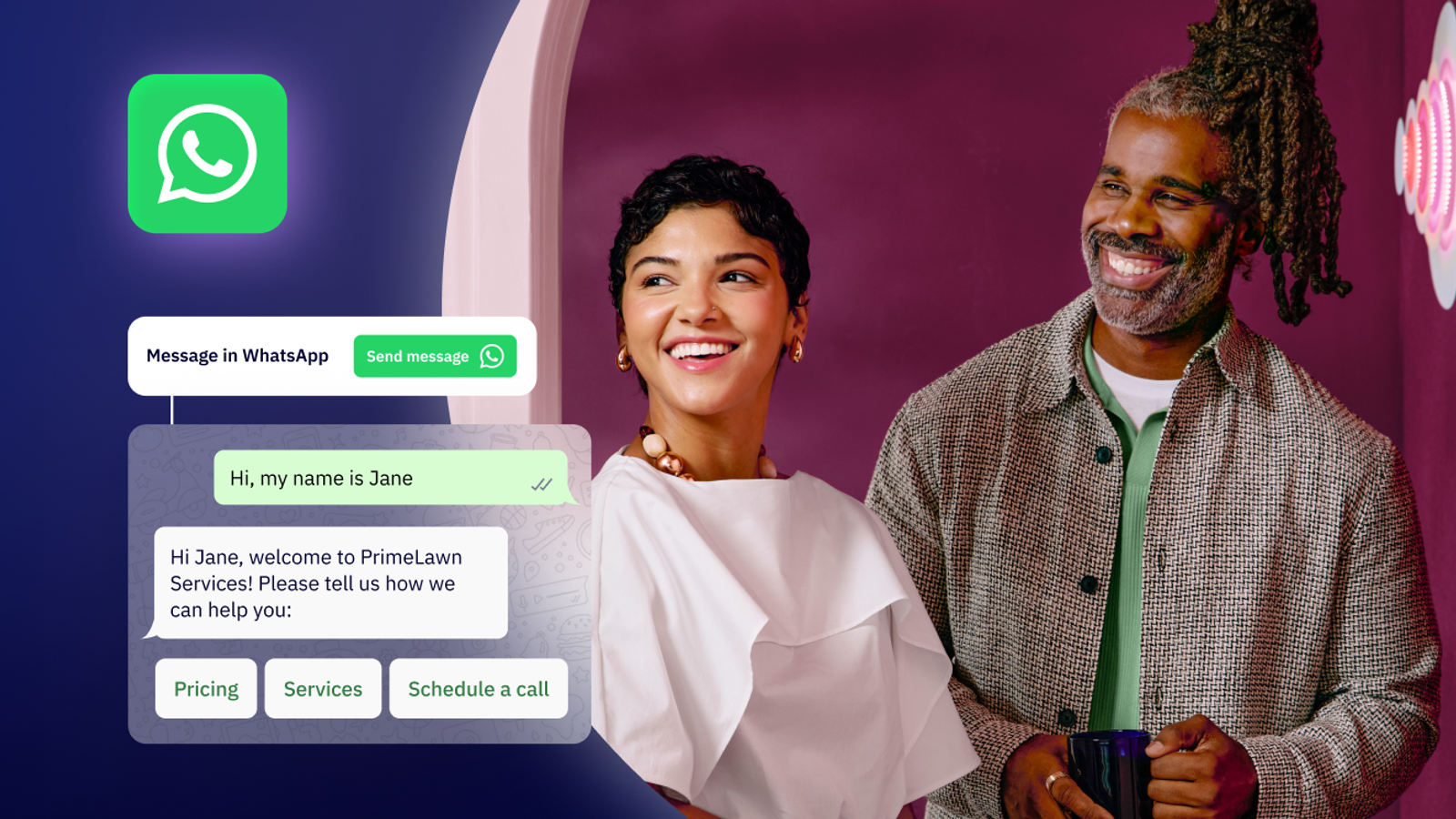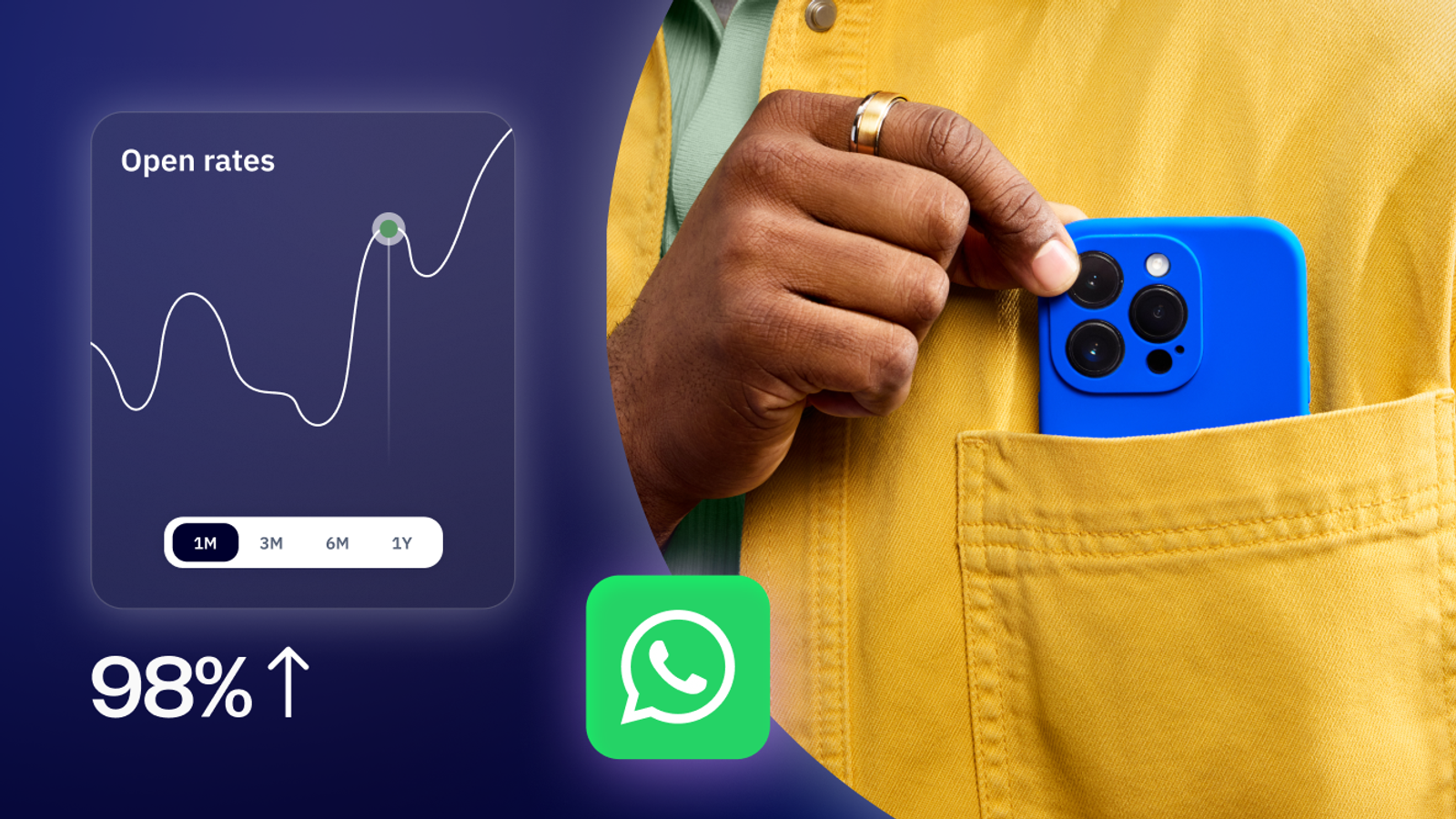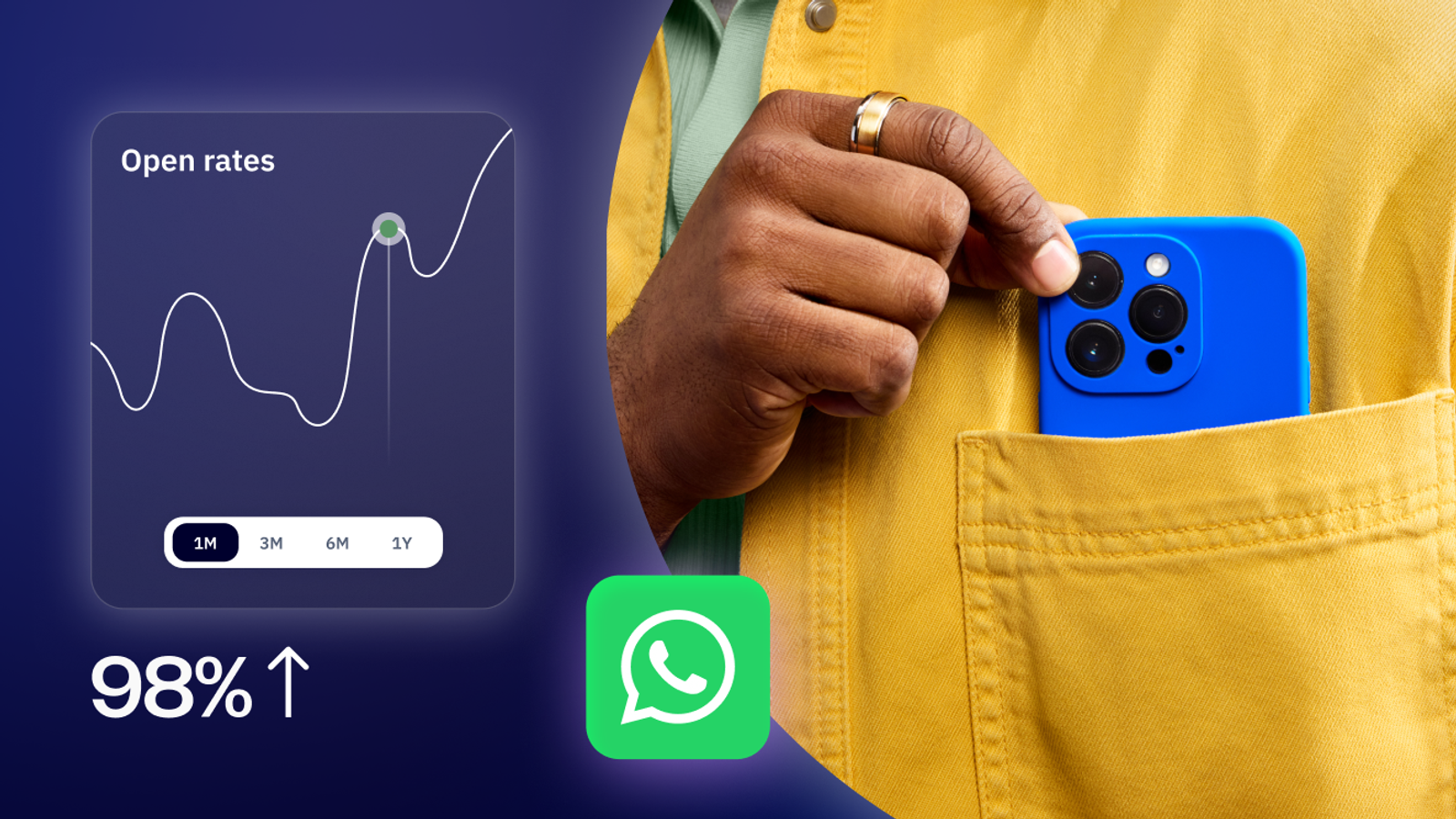When it comes to messaging apps, few are as popular as WhatsApp. For over 2 billion users in 180 countries, WhatsApp isn’t just their preferred communication channel—it’s also where they shop, send and receive money, schedule appointments, and much more. It’s a powerful tool driving real business results, with 69% of consumers making a purchase after talking to a brand on WhatsApp.
When marketers integrate WhatsApp into their existing email and SMS strategies, they can create a cohesive customer experience that drives bottomline results.
The in’s and out’s of WhatsApp
What makes WhatsApp a valuable channel goes beyond its impressive 98% open rate. Compared to email and SMS, WhatsApp offers an intimate and immediate connection, with 58% of WhatsApp messages receiving a response within a minute.
WhatsApp provides rich media capabilities such as voice notes, document uploads, images, polls, stickers and more to set it apart from a standard email or text campaign. WhatsApp also enables responsive two-way communication at scale; these conversations can be complex, nuanced, and ongoing to help businesses build relationships instead of just broadcasting announcements.
Because WhatsApp’s not a discovery channel, it plays a fairly minimal role in the awareness stage compared to email and social media. It takes on a supporting role at the consideration stage, where brands can use WhatsApp to answer questions and provide personalized support. But where WhatsApp really shines is at the decision and retention stages, where businesses can offer onboarding support, post-purchase status updates, and much more.
Creating a cross-channel framework
When brands view WhatsApp, email, and SMS as complementary tools in a unified strategy, they’ll create customer experiences that are far more effective than the sum of their parts.
Consider how email and WhatsApp marketing work hand-in-hand to create seamless cusotmer experiences. With email, you can send comprehensive resources to prospects and customers, helping to educate and build long-term relationships over time. But when your prospect is ready to buy, they might have questions about pricing and features that they’ll want answers to immediately. Instead of waiting for an email reply, prospects can move the conversation to WhatsApp for real-time support and accelerate buying timelines.
While SMS offers similar capabilities as WhatsApp, it’s better utilized for one-way conversations and serves as a bridge between WhatsApp and email. Send a text message for time-sensitive alerts, then share a WhatsApp option if additional context or conversation is needed. For example, if you send an appointment reminder via SMS, you can include a link to WhatsApp with the option to reschedule or get in touch with the front desk. Text message grabs your audience’s attention, while WhatsApp handles the conversation details.
On the flip side, the personal details you collect through a WhatsApp conversation can better inform your email segmentation and SMS targeting strategy. Segmenting contacts ensures they get the content they’re looking for and improves your chance of converting, creating a better experience for both parties involved. The key is to maintain consistent messaging, tone, and brand voice across every customer touchpoint while taking advantage of each channel’s unique capabilities.
At the end of the day, the goal is to make customers feel like they’re having one continuous conversation with your business, regardless of which channel they’re using.
From lead nurture to lead qualification
If you’re unsure where to start with building your cross-channel strategy, there are three opportunities you can start plugging in WhatsApp today to drive immediate results.
1. Qualified lead generation
One of WhatsApp’s strengths is converting email and SMS interactions into paying customers. If your email campaigns are struggling to convert, consider adding a click-to-chat WhatsApp button to give prospects an easy way to get immediate answers from your business.
Suppose you’re running an email campaign for an insurance company. With a WhatsApp chat button, you can guide high-value prospects to the right coverage options in just a couple clicks. Similarly, if you send an SMS campaign promoting a new policy or special rate, directing contacts to WhatsApp for additional information can help you better qualify leads and better understand what kind of policies they’re looking for.
Kredi, a mortgage loan marketplace based in Mexico, uses a WhatsApp chatbot to profile their leads so they can assign prospects to the best agent possible as quickly as possible. Their chatbot helped Kredi recover 80% of incomplete requests, increase the delivery of authentication messages by 99%, and resolve customer questions 30% faster.
2. Customer onboarding and education
Don’t just rely on email for customer onboarding; a WhatsApp message can help get your customer the information they need to get up and running in no time. After sending a welcome email, automate a WhatsApp invitation to invite customers to reach out for personalized or immediate support.
AgendaPro, an administration management and scheduling solution, uses WhatsApp to quickly onboard new customers as soon as they create an account. For example, when you sign up for a trial, you’ll automatically receive a WhatsApp message with options for getting online advice, scheduling a call with a service agent, or reviewing pricing and plan information.
3. Sales and conversion optimization
When it comes to abandoned carts and sales follow-up, time is of the essence, but how and what you reach out with matters too. You can still use email as part of your abandonment sequence, but adding SMS and WhatsApp gives you additional touchpoints to increase your recovery rates.
When someone abandons their cart, they first get an email reminder with what they left behind and then businesses follow up with an SMS text. If both go unread, businesses can use WhatsApp to personalize outreach further with an offer to speak to a sales representative, provide additional product information, or even talk pricing negotiations.
Carvuk, a car servicing platform located in Chile, accelerates the sales process by sending quote estimates to prospects as soon as they inquire about a service. By cutting down on wait times, they can more effectively keep prospects engaged and increase their chances of completing a service booking.
This multi-channel approach across these touchpoints accounts for different communication preferences without sacrificing timeliness or personalization. Some of your customers might ignore their email inbox but respond to a text or WhatsApp message within minutes. Having a cross-channel strategy ensures you’re always showing up for your contacts with the right content at the right time and place.
Unifying your cross-channel approach with ActiveCampaign
One of the biggest challenges marketers face today isn’t understanding the importance of WhatsApp, email, and SMS. Rather, it’s managing three different communication channels that tend to live in siloed systems.
ActiveCampaign eliminates this complexity by bringing all three channels under one roof with native integrations and powerful automation tools to orchestrate one cohesive marketing strategy. With ActiveCampaign WhatsApp Messaging, businesses can:
- Automatically organize and automate follow-ups with contact leads
- Creatine WhatsApp Flows for a variety of scenarios, including resolving customer questions, completing an application, and assigning chats to the right agent
- Measure and optimize WhatsApp sequences with real-time data
- Track all active conversations with a shared team inbox
- Re-market to contacts with up-to-date conversion data from Click-to-WhatsApp ads
Additionally, WhatsApp Messaging makes it easy for businesses to coordinate campaigns across multiple channels. For example, when a contact is added through a WhatsApp conversation, they’re automatically added to your email segments in ActiveCampaign. When a contact engages with a text campaign, their behavior is logged and used to inform a WhatsApp or email sequence. Everything lives in the same dashboard where you already manage your email and SMS campaigns, creating a consistent experience for your customers where they feel both seen and heard.
The end result is a cross-channel marketing strategy that’s both efficient and effective. With a solution like ActiveCampaign, you can focus on getting customers the resources and support they need on the communication channel of their preference, seamlessly and consistently. Businesses that recognize WhatsApp as the final piece of their cross-channel strategy to support email and SMS will deliver exceptional customer experiences that single-channel approaches will never achieve.
FAQs
How does ActiveCampaign help unify WhatsApp, email, and SMS marketing into a single strategy?
ActiveCampaign brings WhatsApp, email, and SMS together in one platform, allowing you to manage all your channels from a single dashboard. You can create unified customer journeys where each channel supports the others, triggering WhatsApp messages based on behaviors like email non-opens or cart abandonment. This eliminates silos, ensures consistent messaging, and makes it easy to orchestrate campaigns that adapt to each customer’s preferences and actions.
How does ActiveCampaign’s WhatsApp Messaging feature streamline campaign setup and automation?
ActiveCampaign’s native WhatsApp integration lets you set up campaigns and automations directly alongside your email and SMS workflows, all from one dashboard. Behavioral triggers can instantly send WhatsApp messages based on customer actions, so you can recover revenue or engage leads without manual intervention. This unified approach eliminates the need for separate tools and makes campaign orchestration seamless.
What are WhatsApp Flows in ActiveCampaign, and how can they simplify customer interactions?
WhatsApp Flows are automated, guided chat sequences that help you qualify leads, answer questions, and route conversations to the right team member. They streamline customer interactions by automating repetitive tasks and ensuring every inquiry is handled efficiently, freeing your team to focus on high-value conversations.
How does ActiveCampaign use behavioral triggers to send WhatsApp messages?
ActiveCampaign lets you send WhatsApp messages instantly based on customer behavior, like when someone abandons a cart, doesn’t open an email, or reaches a key milestone. These real-time triggers are built directly into your automations, so WhatsApp messages are delivered the moment a contact takes (or skips) an action. This helps you recover lost revenue, re-engage customers, and keep conversations moving without delay.





